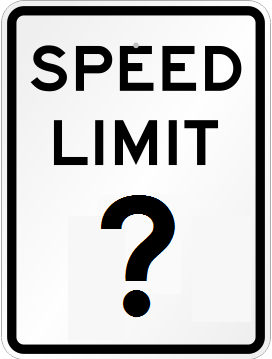When the city or state completes a new major road or highway, the road’s final maximum speed limit will typically not be known until you have your say. Engineers have a speed in mind during design and construction, but they will want your assessment before they can finalize and post the maximum speed limit. No need to go online or fill out a survey– you merely drive on the road to cast your vote.
By definition, 85 percent of drivers are so conscientious and have such solid instincts for safe driving speeds, they will drive below the safe and reasonable speed without any prompting. If you are one of these drivers, and statistically most of you are, you don’t want to get hurt, don’t want to hurt others, and you have developed instincts for sight-lines, cross-traffic, lane-width factors, and risks of objects or pedestrians entering the road. You also have somewhere you need to be, and you don’t want to waste time driving too slow. When you drive on a new road, you are part of what is known as the 85th percentile, and your top speed will typically help set the maximum speed limit.
Of course it is a little more complicated. Residential speed limits and school speed limits will be limited by code. And no speed limits will exceed 70 MPH by federal mandate. Engineers must account for any hidden hazards (like irregular sharp turns) and secondary issues (like breakdown shoulders) before posting their final limit. There are many complex manuals on how to do this. But no matter what engineers decide, they’ll give a lot of deference to the 85th percentile speed. In many cases, the 85th percentile speed, rounded to the nearest 5 MPH, will end up being the posted Maximum. Here is the Federal Highway Commission website that helps engineers through this process.
Of course, our instinct to know safe speeds makes us immediately recognize the unsafe drivers, and I’m not talking about the ones going 5-7 over the limit. We’re all seeing increasing incidences of drag racing, drunk driving, and flat out reckless driving on all our roads the last couple years, and for the 85 % of us that set the speed limit, this is pretty worrisome.



This is a really neat statistic about how traffic works. It’s enlightening to know how speed limits get set. Thanks for sharing.
The NACTO speed manual you linked describes a trend (pg. 18) where modeling speed limit after distribution of driver speeds just leads to higher and higher speed limits.
Regardless of how the speed limit gets set, we need fewer reckless drivers on the road.
Thanks for this and your other great comments Frank. I’m impressed that you read this in the manual. I sometimes wonder if I’m the only one interested in reading through lengthy documents like this, and it’s nice to see there are others. I have to agree that that section of page 18 throws some cold water on the premise that drivers will basically settle on the safe speed. I made a reference to it in my early draft of my article, and then decided I was getting too wordy as I’m prone to do, so I took it out.
As you succinctly summarize, the section points out that after a city has set a speed limit with the 85% rule, if they come back and repeat it sometime later they will find that 85 % of the drivers are going faster than before. My take-away from this is that cities should do a good job with their 85 % determination the first time, getting a good long sample, and then set the speed limit and stick with this value unless the road undergoes a major change. I assume there is a driver psychology or training experience, among a percentage of generally-safe drivers, that encourages them to almost obey the posted speed limit but push it by a few miles an hour. These drivers probably aren’t causing many accidents or getting many tickets, so it works for them. This is a little different from the way I typically drive, which is a pay close attention to the road surface and hazards, and drive what I believe to be a safe speed, rarely even noticing the posted speed. (I have never received a ticket in 45 years of driving with my method, and I keep my eyes on the road instead of scanning for speed signs, so it works for me.) It’s probably the people slightly-pushing the posted speed that create the effect of ever-increasing speeds, and the best way to combat it is to stick with the first 85 percent number. And the hypothesis holds that drivers are self-motivated to be basically safe drivers, with a few exceptions.
Thanks for the thoughtful response.
If setting the 85 percentile speed limit only works one time when there is no baseline, I wonder what this implies about human psychology. If the 85 percentile increases once a reference point has been set as a speed limit, maybe the first round of calibrating the speed reflects drivers’ uncertainties that they will be caught speeding. This could imply that drivers behave more safely when they are not sure if they will be pulled over and they are not sure how fast they should be driving. If that’s the case, it’s extra support for your argument that more traffic enforcement is needed.
Thanks for maintaining this great blog and for your advocacy for public safety. I love reading great about what’s going on in Renton.